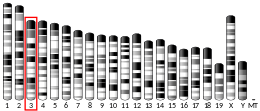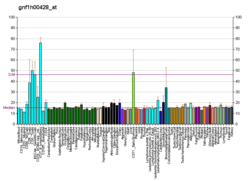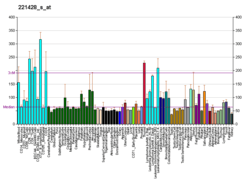TBL1XR1
F-box-like/WD repeat-containing protein TBL1XR1 is a protein that in humans is encoded by the TBL1XR1 gene.[5][6][7] The protein encoded by this gene has sequence similarity with members of the WD40 repeat-containing protein family. The WD40 group is a large family of proteins that appear to have a regulatory function. It is believed that the WD40 repeats mediate protein–protein interactions, and members of the family are involved in signal transduction, RNA processing, gene regulation, vesicular trafficking, cytoskeletal assembly and may play a role in the control of cytotypic differentiation.[7]
Clinical significance
Mutations in TBL1XR1 cause Pierpont syndrome, which involves intellectual disability, a characteristic facial appearance and limb abnormalities.[8]
Mutations in TBL1XR1 have been identified in lymphomas, including MYD88 wild-type Waldenstrom's macroglobulinemia.[9]
Interactions
TBL1XR1 has been shown to interact with nuclear receptor co-repressor 1.[6][10][11]
References
- GRCh38: Ensembl release 89: ENSG00000177565 - Ensembl, May 2017
- GRCm38: Ensembl release 89: ENSMUSG00000027630 - Ensembl, May 2017
- "Human PubMed Reference:". National Center for Biotechnology Information, U.S. National Library of Medicine.
- "Mouse PubMed Reference:". National Center for Biotechnology Information, U.S. National Library of Medicine.
- Zhang X, Dormady SP, Basch RS (Jan 2001). "Identification of four human cDNAs that are differentially expressed by early hematopoietic progenitors". Exp Hematol. 28 (11): 1286–96. doi:10.1016/S0301-472X(00)00539-7. PMID 11063877.
- Zhang J, Kalkum M, Chait BT, Roeder RG (Apr 2002). "The N-CoR-HDAC3 nuclear receptor corepressor complex inhibits the JNK pathway through the integral subunit GPS2". Mol Cell. 9 (3): 611–23. doi:10.1016/S1097-2765(02)00468-9. PMID 11931768.
- "Entrez Gene: TBL1XR1 transducin (beta)-like 1X-linked receptor 1".
- "OMIM Entry - # 602342 - PIERPONT SYNDROME; PRPTS". www.omim.org. Retrieved 2020-04-05.
- Hunter et al, Proc. American Society for Hematology 2017; Abstract 4011
- Yoon, Ho-Geun; Chan Doug W; Reynolds Albert B; Qin Jun; Wong Jiemin (Sep 2003). "N-CoR mediates DNA methylation-dependent repression through a methyl CpG binding protein Kaiso". Mol. Cell. 12 (3): 723–34. doi:10.1016/j.molcel.2003.08.008. ISSN 1097-2765. PMID 14527417.
- Yoon, Ho-Geun; Chan Doug W; Huang Zhi-Qing; Li Jiwen; Fondell Joseph D; Qin Jun; Wong Jiemin (Mar 2003). "Purification and functional characterization of the human N-CoR complex: the roles of HDAC3, TBL1 and TBLR1". EMBO J. 22 (6): 1336–46. doi:10.1093/emboj/cdg120. ISSN 0261-4189. PMC 151047. PMID 12628926.
Further reading
- Strausberg RL, Feingold EA, Grouse LH, et al. (2003). "Generation and initial analysis of more than 15,000 full-length human and mouse cDNA sequences". Proc. Natl. Acad. Sci. U.S.A. 99 (26): 16899–903. Bibcode:2002PNAS...9916899M. doi:10.1073/pnas.242603899. PMC 139241. PMID 12477932.
- Yoon HG, Chan DW, Huang ZQ, et al. (2003). "Purification and functional characterization of the human N-CoR complex: the roles of HDAC3, TBL1 and TBLR1". EMBO J. 22 (6): 1336–46. doi:10.1093/emboj/cdg120. PMC 151047. PMID 12628926.
- Yoon HG, Chan DW, Reynolds AB, et al. (2003). "N-CoR mediates DNA methylation-dependent repression through a methyl CpG binding protein Kaiso". Mol. Cell. 12 (3): 723–34. doi:10.1016/j.molcel.2003.08.008. PMID 14527417.
- Ota T, Suzuki Y, Nishikawa T, et al. (2004). "Complete sequencing and characterization of 21,243 full-length human cDNAs". Nat. Genet. 36 (1): 40–5. doi:10.1038/ng1285. PMID 14702039.
- Perissi V, Aggarwal A, Glass CK, et al. (2004). "A corepressor/coactivator exchange complex required for transcriptional activation by nuclear receptors and other regulated transcription factors". Cell. 116 (4): 511–26. doi:10.1016/S0092-8674(04)00133-3. PMID 14980219.
- Gerhard DS, Wagner L, Feingold EA, et al. (2004). "The status, quality, and expansion of the NIH full-length cDNA project: the Mammalian Gene Collection (MGC)". Genome Res. 14 (10B): 2121–7. doi:10.1101/gr.2596504. PMC 528928. PMID 15489334.
- Yoon HG, Choi Y, Cole PA, Wong J (2005). "Reading and function of a histone code involved in targeting corepressor complexes for repression". Mol. Cell. Biol. 25 (1): 324–35. doi:10.1128/MCB.25.1.324-335.2005. PMC 538779. PMID 15601853.
- Zhang XM, Chang Q, Zeng L, et al. (2006). "TBLR1 regulates the expression of nuclear hormone receptor co-repressors". BMC Cell Biol. 7: 31. doi:10.1186/1471-2121-7-31. PMC 1555579. PMID 16893456.
- Liu Y, Sun W, Zhang K, et al. (2007). "Identification of genes differentially expressed in human primary lung squamous cell carcinoma". Lung Cancer. 56 (3): 307–17. doi:10.1016/j.lungcan.2007.01.016. PMID 17316888.





